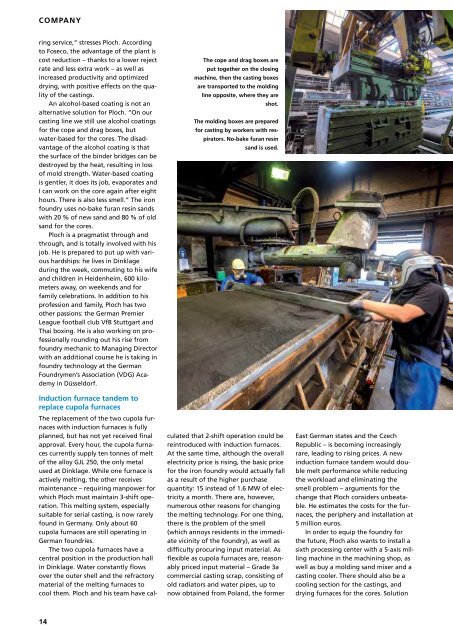CPT International 01/2019
You also want an ePaper? Increase the reach of your titles
YUMPU automatically turns print PDFs into web optimized ePapers that Google loves.
COMPANY<br />
ring service,” stresses Ploch. According<br />
to Foseco, the advantage of the plant is<br />
cost reduction – thanks to a lower reject<br />
rate and less extra work – as well as<br />
increased productivity and optimized<br />
drying, with positive effects on the quality<br />
of the castings.<br />
An alcohol-based coating is not an<br />
alternative solution for Ploch. “On our<br />
casting line we still use alcohol coatings<br />
for the cope and drag boxes, but<br />
water-based for the cores. The disadvantage<br />
of the alcohol coating is that<br />
the surface of the binder bridges can be<br />
destroyed by the heat, resulting in loss<br />
of mold strength. Water-based coating<br />
is gentler, it does its job, evaporates and<br />
I can work on the core again after eight<br />
hours. There is also less smell.” The iron<br />
foundry uses no-bake furan resin sands<br />
with 20 % of new sand and 80 % of old<br />
sand for the cores.<br />
Ploch is a pragmatist through and<br />
through, and is totally involved with his<br />
job. He is prepared to put up with various<br />
hardships: he lives in Dinklage<br />
during the week, commuting to his wife<br />
and children in Heidenheim, 600 kilometers<br />
away, on weekends and for<br />
family celebrations. In addition to his<br />
profession and family, Ploch has two<br />
other passions: the German Premier<br />
League football club VfB Stuttgart and<br />
Thai boxing. He is also working on professionally<br />
rounding out his rise from<br />
foundry mechanic to Managing Director<br />
with an additional course he is taking in<br />
foundry technology at the German<br />
Foundrymen’s Association (VDG) Academy<br />
in Düsseldorf.<br />
The cope and drag boxes are<br />
put together on the closing<br />
machine, then the casting boxes<br />
are transported to the molding<br />
line opposite, where they are<br />
shot.<br />
The molding boxes are prepared<br />
for casting by workers with respirators.<br />
No-bake furan resin<br />
sand is used.<br />
Induction furnace tandem to<br />
replace cupola furnaces<br />
The replacement of the two cupola furnaces<br />
with induction furnaces is fully<br />
planned, but has not yet received final<br />
approval. Every hour, the cupola furnaces<br />
currently supply ten tonnes of melt<br />
of the alloy GJL 250, the only metal<br />
used at Dinklage. While one furnace is<br />
actively melting, the other receives<br />
maintenance – requiring manpower for<br />
which Ploch must maintain 3-shift operation.<br />
This melting system, especially<br />
suitable for serial casting, is now rarely<br />
found in Germany. Only about 60<br />
cupola furnaces are still operating in<br />
German foundries.<br />
The two cupola furnaces have a<br />
central position in the production hall<br />
in Dinklage. Water constantly flows<br />
over the outer shell and the refractory<br />
material of the melting furnaces to<br />
cool them. Ploch and his team have calculated<br />
that 2-shift operation could be<br />
reintroduced with induction furnaces.<br />
At the same time, although the overall<br />
electricity price is rising, the basic price<br />
for the iron foundry would actually fall<br />
as a result of the higher purchase<br />
quantity: 15 instead of 1.6 MW of electricity<br />
a month. There are, however,<br />
numerous other reasons for changing<br />
the melting technology. For one thing,<br />
there is the problem of the smell<br />
(which annoys residents in the immediate<br />
vicinity of the foundry), as well as<br />
difficulty procuring input material. As<br />
flexible as cupola furnaces are, reasonably<br />
priced input material – Grade 3a<br />
commercial casting scrap, consisting of<br />
old radiators and water pipes, up to<br />
now obtained from Poland, the former<br />
East German states and the Czech<br />
Republic – is becoming increasingly<br />
rare, leading to rising prices. A new<br />
induction furnace tandem would double<br />
melt performance while reducing<br />
the workload and eliminating the<br />
smell problem – arguments for the<br />
change that Ploch considers unbeatable.<br />
He estimates the costs for the furnaces,<br />
the periphery and installation at<br />
5 million euros.<br />
In order to equip the foundry for<br />
the future, Ploch also wants to install a<br />
sixth processing center with a 5-axis milling<br />
machine in the machining shop, as<br />
well as buy a molding sand mixer and a<br />
casting cooler. There should also be a<br />
cooling section for the castings, and<br />
drying furnaces for the cores. Solution<br />
14

















